Caption:
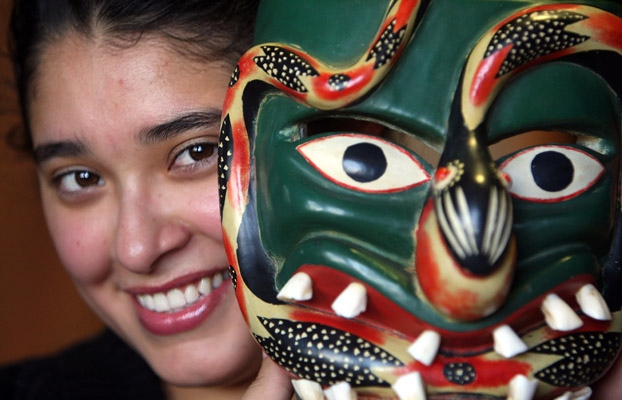 Caption: Student Carolina Santillan holds up one of the masks that are part of the Phurépecha exhibit at the Anthropology Teaching Museum through Dec. 22. Photo by Karen TapiaDownload Photo
Caption: Student Carolina Santillan holds up one of the masks that are part of the Phurépecha exhibit at the Anthropology Teaching Museum through Dec. 22. Photo by Karen TapiaDownload Photo
Cultural Treasures of Mexico
CSUF Museum Exhibit Features Pre-Hispanic Civilization
May 4, 2011 | Updated July 15, 2011 :: No. 140
What: Cal State Fullerton’s Anthropology Teaching Museum opens a new exhibit, “Cultural Treasures of Mexico: The Phurépecha of Parangaricutiro,” featuring pre-Hispanic and contemporary civilization from the Michoacán, Mexico region.
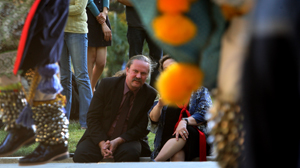 Opening event: The free
May 12 opening event, attended by more than 200 people, featured
the heritage of the Phurépecha, or Tarascan, people of Michoacán
through dance, food and bilingual tours of the exhibit, as well as a
performance by the award-winning Cúrpite Dancers of Nuevo
Parangaricutiro, who hail from Paso Robles.
Opening event: The free
May 12 opening event, attended by more than 200 people, featured
the heritage of the Phurépecha, or Tarascan, people of Michoacán
through dance, food and bilingual tours of the exhibit, as well as a
performance by the award-winning Cúrpite Dancers of Nuevo
Parangaricutiro, who hail from Paso Robles.
View more photos from opening day on flikr.
Exhibit hours: 9 a.m.-5 p.m. Monday-Friday May 13-Dec. 22.
Where: Anthropology Teaching Museum, Room 426 of McCarthy Hall
Cal State Fullerton, 800 N. State College Blvd., Fullerton, 92831
Caption:
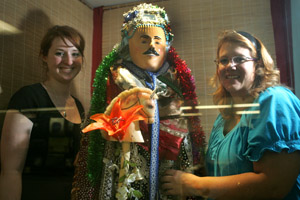 Caption: Heather Strough, left, and Kandy Black arrange a traditional costume of a dancer from the Phurépecha culture. Photo by Karen Tapia Download Photo
Caption: Heather Strough, left, and Kandy Black arrange a traditional costume of a dancer from the Phurépecha culture. Photo by Karen Tapia Download Photo
On display: The exhibit features artifacts on loan from the Bowers Museum and Phurépecha diasporan communities, including information about the explosion of the Paricutin Volcano, which was the first recorded birth of a volcano in the Americas. The volcano buried San Juan Parangaricutiro and the neighboring community of Paricutin/San Salvador Cumbutzio in 1943. Artifacts on display include: rings, likely worn by Phurépecha nobility from the Uacusecha (Eagle) lineage; bells associated with rainmaking rituals; and a troje, a replica of a Phurépecha house made of two types of pine and fir with a trapezoidal-shaped roof.
Why: “The goals are to educate the public about the rich cultural history of the Phurépecha people and to provide the diasporan Phurépecha community in the United States with access to information about their history, culture and language through this exhibit,” said Tricia Gabany-Guerrero, assistant professor of anthropology, who is curating the exhibit with students in her “Museum Science” class. “The exhibit will highlight the ritual aspects of everyday life, both those that have remained and those that have transformed, over time. The topics of ritual include: ceramics, obsidian production, art, language, music, the influence of environment, ancient rock art and the dance of the Cúrpites, which is specific to Parangaricutiro.”
Additional: The exhibit highlights accomplishments and traditions of the Phurépecha people, specifically the heritage of San Juan Parangaricutiro, which was destroyed by the Paricutín volcano in 1943. The exhibit is the culmination of a semester-long project of Gabany-Guerrero’s class, which class consists of four graduate and 10 undergraduate students. In the course of their curation efforts, they learned how to build the exhibit, research the subject and request artifact loans from museums, among other skills. The university’s Anthropology Teaching Museum is working in conjunction with the Nuevo Parangaricutiro Community (Municipio) Museum in Mexico.
Sponsors: Bowers Museum, Mexican Environmental and Cultural Research Institute and the Mexican Consulate of Santa Ana, as well as CSUF’s College of Humanities and Social Sciences, Student Affairs and Associated Students Inc.
Website: http://www.purepecha.org/museum/
Parking: $2 per hour or $8 for a daily permit Monday through Friday. Details available online: http://parking.fullerton.edu/visitors
Media Contacts:
Tricia Gabany-Guerrero, Anthropology, 657-278-3393 or tgabany-guerrero@fullerton.edu
Mimi Ko Cruz, Public Affairs, 657-278-7586, mkocruz@fullerton.edu
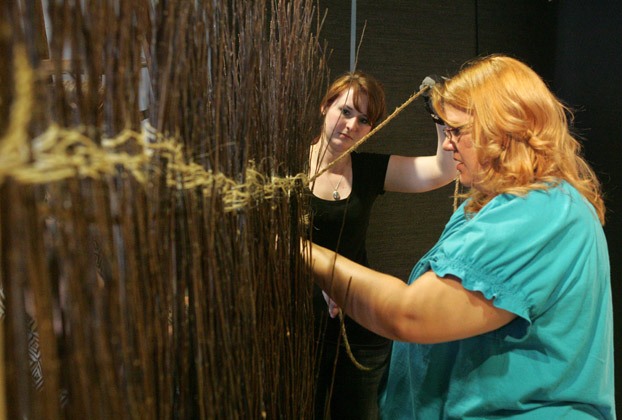 Caption: Students Kandy Black, right, and Heather Strough, help prepare the
Phurépecha exhibit in the Anthropology Teaching Muesum on campus. Photo by Karen TapiaDownload Photo
Caption: Students Kandy Black, right, and Heather Strough, help prepare the
Phurépecha exhibit in the Anthropology Teaching Muesum on campus. Photo by Karen TapiaDownload Photo
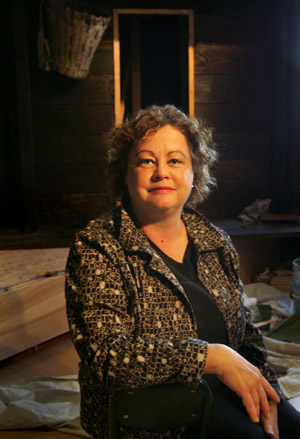 Tricia Gabany-Guerrero sits in front of a troje, a replica of a Phurépecha house on display in the upcoming “Cultural Treasures of Mexico: The Phurépecha of Parangaricutiro,” exhibit. Photo by Karen Tapia
Tricia Gabany-Guerrero sits in front of a troje, a replica of a Phurépecha house on display in the upcoming “Cultural Treasures of Mexico: The Phurépecha of Parangaricutiro,” exhibit. Photo by Karen Tapia